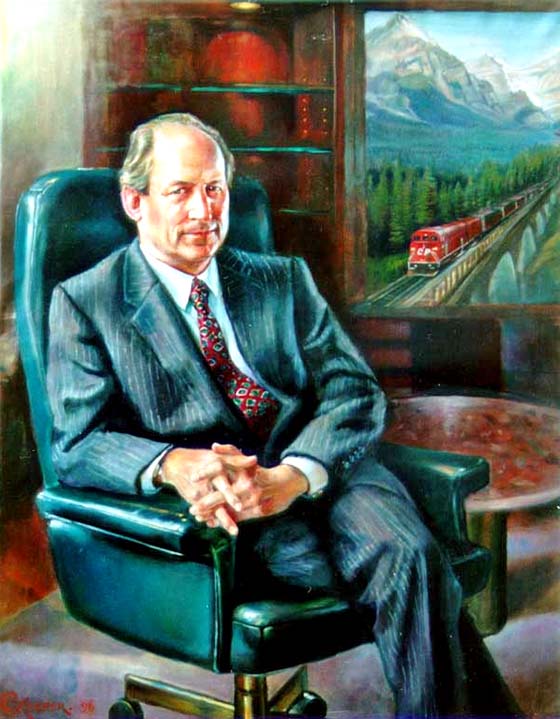|
Computers and Communications
are Important Productivity Tools

Canadian Pacific President Bill Stinson - Date/Artist unknown.
Toronto - Railways may be entering a period as vital to their fundamental efficiency as dieselization was 30 years ago,
only this time computers and communications may be leading the way.
Canadian Pacific President Bill Stinson made the assessment in a speech to the Association of American Railroads' (AAR) Communication
and Signals Division here last month.
While the recession and the uncertainty that follows may have shaken people's faith in economic growth, "hunkering down and
thinking small only serve as short-term survival tactics. They are not strategies for long term growth... and growth is there", he
said.
OPPORTUNITIES
"Clearly, the businesses that will be able to capitalize on opportunities for growth will be those that can be low-cost
producers and which can enhance their cost and service competitiveness by prudent updating of plant and equipment".
Productivity-generating investments, such as traffic control systems, which have had to be postponed because of capital spending
restraints, cannot be postponed forever, he added. "They are essential to enhancing capacity, reducing delays, and controlling fuel
and crew costs and, most importantly, increasing safety".
"But new systems are expensive and management must ensure that they fill real operational and business needs".
While basic Centralized Traffic Control (CTC) systems have performed admirably, for example, Mr. Stinson said North American railways
may not be getting as much productivity from traffic control as they might.
SERIOUS EXAMINATION
"I believe the time has come to seriously examine what is needed for better traffic control and then to take a hard look at some
of the technological options that are either available now, or under development", he told the railwaymen.
The most efficient approach to the problem is for railways with common concerns to participate in joint research ventures to
establish operating requirements and design criteria for enhanced traffic control systems.
This approach has been taken recently by seven railways in a joint Canada-U.S. train control project which could lead to an AAR
standard, he said. The participating railways are CP Rail, CN Rail, Algoma Central, Norfolk-Southern, Chessie, Seaboard, and Burlington
Northern.
OBJECTIVES
Mr. Stinson said the project has four objectives:
- The development of a radio-based cab display system to provide low-cost train control on territory now operated through train
orders;
- Further refine computer-aided dispatching so that required speeds for trains approaching a meet can be calculated and displayed to
the locomotive engineer. This would allow trains to arrive for meets at precisely the right moment and would avoid the
stop-and-start fuel waste caused by a train approaching a meet at track speed, only to arrive early;
- Improving fuel savings and increasing track capacity from a "moving block" system where safe spacing between following
trains would be established by computation. A speed reduction would be relayed to the cab of the following train whenever the safety
margin is approached;
- Developing an automated way, through innovative computer programming, of keeping main line managers informed of impending delays
in yards, and vice-versa. Both main line and yard operations may expend fuel and staff needlessly, unaware of congestion elsewhere.
"If the management of main line and yard operations can be coordinated automatically, it will reduce one of the major cost
elements that is still largely beyond the control of the people involved", he said.
"This project will not replace CTC, nor necessarily displace it, but will renew and continue the evolutionary process",
said Mr. Stinson. "Projects such as these, however, are just a small sample of the potential of computers and communications as
tools to enhance the productivity of railway operations".
MANAGING TECHNOLOGY
Mr. Stinson said the challenge to signal and communications executives goes beyond mastering and managing technological change.
"The real challenge will be to assess the long-term implications of technology for the continued functioning of the railway as a
business which must be both viable and cost-competitive", he said.
Meeting this challenge, however, will require constant reference to the basic business principles that capital resources are finite
and that spending has to be assigned to meet real needs and to maximize opportunities for productivity and cost-competitiveness.
"Opportunities to meet real needs through technology will also have to compete for capital with the equally real needs of simply
keeping the railway in shape, upgrading and replacement programs for track and structures, locomotives and freight cars", he
said.

|